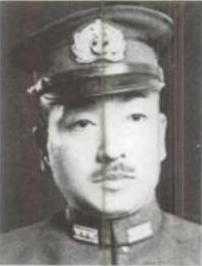Shigeyoshi Miwa
| Miwa Shigeyoshi | |
|---|---|
 Vice Admiral Miwa Shigeyoshi | |
| Born |
May 15, 1892 Aichi Prefecture, Japan |
| Died | February 27, 1959 (aged 66)[1] |
| Allegiance | Empire of Japan |
| Service/branch |
|
| Years of service | 1911-1945 |
| Rank | Vice Admiral |
| Commands held | IJN 6th Fleet |
| Battles/wars | World War II |
Shigeyoshi Miwa (三輪 茂義 Miwa Shigeyoshi, May 15, 1892 – February 27, 1959), was an admiral in the Imperial Japanese Navy during World War II. He commanded the Japanese submarine forces during the attack on Pearl Harbor.
Biography
Miwa was a native of Aichi prefecture, and graduated 59th out of 148 cadets in the 39th class of the Imperial Japanese Navy Academy in 1911. He served his midshipman duty on the cruiser Aso and battleship Mikasa, and as a sub-lieutenant on Chikuma, Iwami and Azuma. In 1917, he attended the Navy Staff College, where he specialized in navigation, torpedo warfare and submarines, transferring to the submarine warfare section as a lieutenant in 1918. He stayed on to become an instructor at the Submarine Warfare school for 1920–1922, and served as acting captain of the S-22 (Ro-14) from May – December 1922. He was promoted to lieutenant commander in 1923.[2]
In 1924, Miwa was given his first true command, that of the S-45 (Ro-26). He became captain of S-59 (Ro-60) the following year. From 1925-1932, Miwa served in various staff positions on the Imperial Japanese Navy General Staff and as an instructor at the Naval Staff College on submarine warfare issues. He was promoted to captain in 1932, and assigned command of the 30th Submarine Group.[3]
From 1935-1936, Miwa was captain of the light cruiser Kinu,[4] and served as Chief of staff of the Mako Guard District from 1936-1938. He was promoted to rear admiral in November 1938. In 1939, he was reassigned back to submarines as commander of the 3rd Submarine Squadron, and was in this position at the time of the attack on Pearl Harbor.[5] His submarines were part of the screening force around Pearl Harbor to prevent any American vessels from escaping during the air raids.[6]
Miwa returned to the Naval General Staff in April 1942 and was promoted to vice admiral in charge of the Naval Shipbuilding Command. In July 1944, he became commander in chief of the IJN 6th Fleet in charge of all submarine operations for the Japanese Navy, and served in this capacity during the Battle of Leyte Gulf.[7][8]
With his forces taking increasing casualties due to the increasing numbers of American destroyers with increasingly effective anti-submarine warfare equipment, Miwa (although initially opposed[9]) became a strong proponent of the Kaiten suicide submarine program.[10] He was relieved of this command and returned to the Navy General Staff in May 1945.
Miwa went into retirement after the surrender of Japan. He died in 1959 at age 66.
References
Books
- Fuller, Richard (1992). Shokan: Hirohito's Samurai. London: Arms and Armour Press. ISBN 1-85409-151-4.
- Boyd, Carl; Yoshida Akihiko (2002). The Japanese Submarine Force and World War II. Naval Institute Press. ISBN 1-55750-080-0.
- Dunnigan, Gordon (1982). Victory at Sea: World War II in the Pacific. Harper. ISBN 0-688-14947-2.
- Goldstein, Donald M (1999). The Pearl Harbor Papers: Inside the Japanese Plans. Potomac Books. ISBN 1-57488-222-8.
- Morison, Samuel Eliot (2002). History of United States Naval Operations in World War II. Vol. 12: Leyte, June 1944-January 1945. Chicago: University of Illinois Press. ISBN 0-252-07065-8.
- Prange, Gordon (1982). At Dawn We Slept: The Untold Story of Pearl Harbor. Penguin. ISBN 0-14-015734-4.
- Sheftal, MG (2005). Blossoms in the Wind: Human Legacies of the Kamikaze. NAL Hardcover. ISBN 0-451-21487-0.
- Wheeler, Keith (1980). War Under the Pacific. Time-Life Books. ISBN 0-8094-3375-3.
External links
- Nishida, Hiroshi. "Imperial Japanese Navy".
- Pacific War On-Line Encyclopedia
Notes
- ↑ Nishida, Hiroshi, Imperial Japanese Navy
- ↑ Nishidah, Imperial Japanese Navy
- ↑ Miwa Shigeyoshi Pacific War On-Line Encyclopedia
- ↑ HIJMS KINU: Tabular Record of Movement, combinedfleet.com
- ↑ Prange. At Dawn We Slept. Page 339
- ↑ Goldstein. The Pearl Harbor Papers, page 272
- ↑ Morison. History of United States Naval Operations in World War II. Vol. 12: Leyte. page 151
- ↑ Padfield. War Beneath the Sea. Page 454
- ↑ Dunnigan. Victory at Sea. Page 454
- ↑ Sheftal. Blossoms in the Wind. page 438